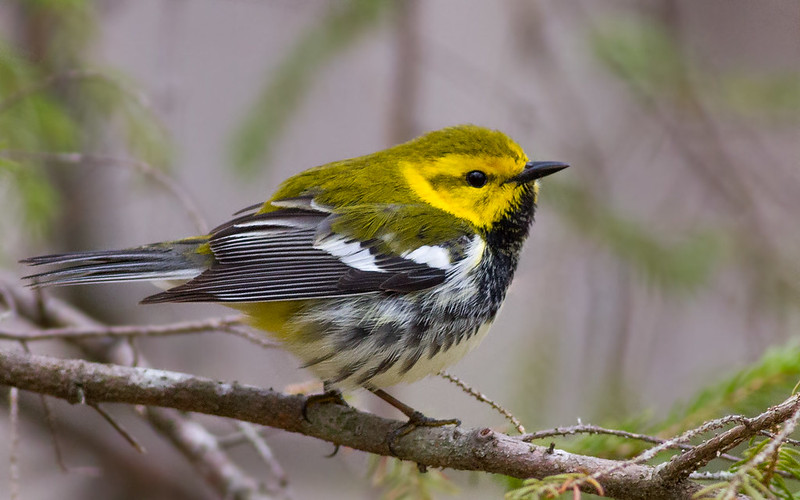You might already know that the ABMI’s Biodiversity Browser is a virtual encyclopedia of life in Alberta—with more than 3,000 species profiles of birds, mammals, amphibians, soil mites, vascular plants, lichens, and mosses at your fingertips! But you may not know the many ways the recently updated portal can support research and reporting. The Biodiversity Browser is a useful source of information on where we’ve detected species, what habitats different species are found in, and the impacts of human activity. Recently, two MSc students in Biological Sciences at the University of Alberta—Taylor Hart and Isabelle Lebeuf-Taylor—shared how data from the Biodiversity Browser supported their research on bird activity in Alberta.
Biodiversity Browser Data: Using Habitat Associations and Predicted Species Distributions to Select Monitoring Sites

A Black-throated Green Warbler, captured by Kyle Taylor, a field technician that helped with fieldwork for the project.
Project: Population Dynamics of Black-throated Green Warblers (Setophaga virens) in Response to Habitat Fragmentation throughout the Boreal Forest of Alberta
In Alberta, information on habitat use of Black-throated Green Warblers (Setophaga virens)—Species of Special Concern—is limited. However, Hart says that the ABMI’s Biodiversity Browser was an especially valuable resource during the initial stages of her project, supplying her with the essential information required to guide the selection of appropriate field sites based on the habitat associations of Black-throated Green Warblers. The Biodiversity Browser shows that these birds are old-growth forest specialists, relying on undisturbed, mixedwood forest stands of 100 to 140 years of age, and the information on the Biodiversity Browser enabled her to select study locations with the age and stand classifications that support the highest numbers of this species.
The figures included in the Biodiversity Browser are useful for presentations, as they clearly depict the habitat associations and human footprint usage pertinent to your species.” Taylor Hart, MSc. student, Biological Sciences, University of Alberta
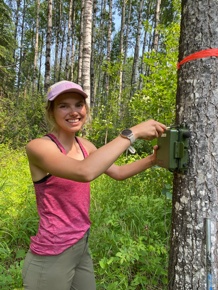
Taylor Hart deploying an Autonomous Recording Unit (ARU) to monitor Black-throated Green Warblers vocalizations in an old-growth forest.
Project Background
Taylor Hart’s research examines the impact of forest fragmentation resulting from forestry and energy sector development on the population dynamics of a Species of Special Concern, the Black-throated Green Warbler, throughout the boreal forest of Alberta. Over the past 25 years, Black-throated Green Warbler populations have experienced a decline of over 50% in Alberta. In the breeding seasons of 2022 and 2023, Hart set up autonomous recordings units (ARUs) at 140 historically sampled sites within suitable Black-throated Green Warbler habitat to capture recordings of species in the area. Hart is analyzing the factors influencing changes in occupancy, both over time and space, and she aims to identify the mechanisms that could be driving the declines in Black-throated Green Warbler populations in their breeding habitat.
The [Biodiversity Browser] is user-friendly and not overly complex… It ensures that all the necessary data is easily interpretable and readily available. Taylor Hart
Using the Biodiversity Browser
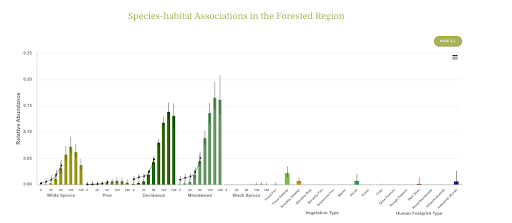
Species-habitat Associations in the Forested Regions
For Hart, the Biodiversity Browser offers comprehensive data on species–habitat associations and predicted species distributions across various types of human disturbances, which are central to her research project.
She notes that although her research is centered around a single species, the Biodiversity Browser provides comparable information for a multitude of species residing in Alberta’s boreal forest, encompassing a range of birds and mammals as well as other species groups that are typically less well studied—vascular plants, lichens, mosses, and soil mites.
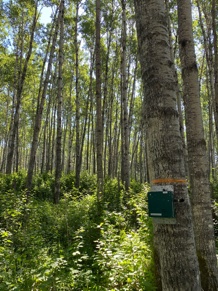
An ARU deployed in old-growth forest near Calling Lake, AB.
Hart says that she appreciates the accessibility of the Biodiversity Browser and the straightforward, at-a-glance information it provides for any species of interest. “The platform is user-friendly and not overly complex,” she says“. It ensures that all the necessary data is easily interpretable and readily available.”
For more information on this project, please contact Taylor Hart.
Biodiversity Browser Data: Using Predicted Habitat Associations in Bird Species Comparisons
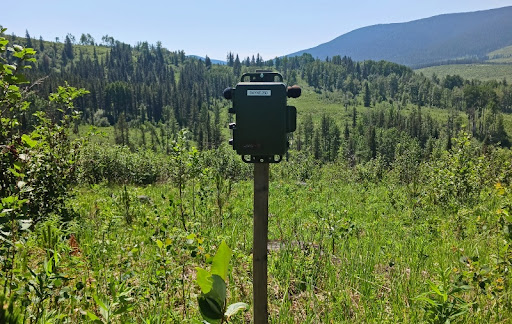
A camera setup in a clearing in Alberta’s foothills.
Project: Bird Response to Small Retention Patches in Harvests in Alberta
Isabelle Lebeuf-Taylor’s study used predicted habitat associations from the Biodiversity Browser to compare how multiple bird species use (or don’t use) harvested areas with tree retention.
The Biodiversity Browser consolidates research from many sources, providing an excellent starting point in asking ecological questions. Isabelle LeBouef, MSc. student, Biological Sciences, University of Alberta
Project Background

Isabelle Lebeuf-Taylor looking at ducks, in an AlPac FMA.
In Alberta, the adoption of ground rules designed to maintain biodiversity and ecosystem functions in harvested areas has led to variations in logging practices in forested areas across the province. A key aspect, tree retention, involves preserving small patches of trees during harvest. However, there’s a gap in understanding the minimal effective patch size for ecological benefits for wildlife. Lebeuf-Taylor’s study examines the ecological benefits of small retention patches for forest birds, and assesses the potential for refining provincial guidelines.
Using the Biodiversity Browser
Lebeuf-Taylor noted that one of the most useful aspects of the Biodiversity Browser is its consolidation of research from many sources, providing an excellent starting point in asking ecological questions. She says that at later stages of a research question, the Biodiversity Browser can be useful in confirming that findings differ from or are aligned with the current expectations outlined in a species’ profile page.

Isabelle Lebeuf-Taylor with feller buncher in a new harvest area.
For more information on this project, please contact Isabelle Lebeuf-Taylor.
Your Experience with the ABMI’s Biodiversity Browser
Have you used the Biodiversity Browser in your work? Please let us know how by emailing abmicoms@ualberta.ca.
If you are interested to know how the ABMI’s Biodiversity Browser or its data can support your project, please contact Katherine Maxcy, the ABMI’s Reporting and Analytics lead.

